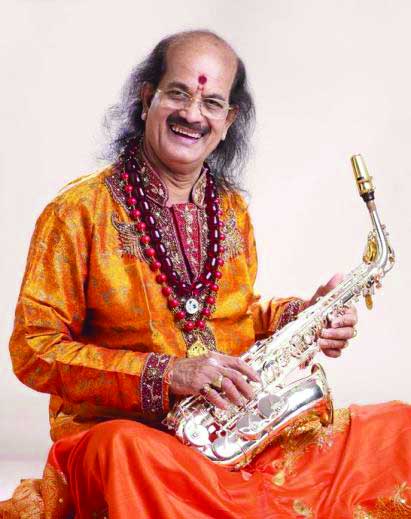An innovator, who put the instrument on the map of Carnatic music, Kadri Gopalnath will be sorely missed by thousands of music lovers worldwide, says Veejay Sai
Last Friday, the world woke up to the news of the sudden demise of Carnatic saxophone maestro Kadri Gopalnath (1949-2019). He was 69, unexpected because he was in great health and has been regularly performing across venues. With his passing, the world of Indian classical music lost a pioneer and an innovator.
Gopalnath was born at Sajeepa Mooda in the Dakshina Kannada Taluk of Bantwal on December 6, 1949. He was the third among nine children of Nagaswaram artiste Taniyappa and Thangamma, a home-maker. He learnt to play the Nagaswaram and clarinet at an early age. It was during some Dussehra celebrations in Mysore that he heard the palace band. The saxophone highly attracted the eight-year-old. He began training in it under Gopalakrishna Iyer in Mangalore and later from Balakrishna Pillai in Kumbakonam. A priest heard him and invited him to perform during a puja in the Kadri temple, which was his official debut. He was only 15.
Growing up in a poor family was not easy for the budding musician. He even rolled beedis to earn some money. He went for various auditions at the AIR and was selected in the ‘B High’ category. After making a debut at the All-India Radio in 1978, there was no looking back. The Bombay Jazz Festival 1980 saw him as an instant hit when he performed with John Handy.
Later, he also went to train with Mridangam maestro and singer Sangita Kalanidhi T V Gopalakrishnan. Fondly addressed as “TVG,” he was already a guru to stalwarts like film music director Ilayaraja and several others. TVG taught him further innovations on the instrument.
While the Nagaswaram has been integral to Carnatic instrumental music from ancient times, being played at temples and other festival ceremonies, the other instruments were fairly alien to the genre. The Mysore Palace was famous for kings who were great patrons of art and music. The palace had its own band, one which inspired Gopalnath. Though initially he performed on the existing saxophones, he eventually worked closely with a company in Hyderabad and engineered his own instrument to adapt it to Carnatic music.
Gopalnath’s innovation on the instrument was unique and original. Until then, nobody had dared to even try playing the complicated Carnatic music notes on it. There were already several artistes playing the clarinet. But the saxophone was unexplored. Well, it was a devil that needed to be tamed. And Gopalnath did it.
Initially, he also faced a lot of opposition from the conservative establishment that patronised the genre. However, eventually, it was through his own music that he was able to convince them that it was possible to have a Carnatic saxophone. Soon some of the biggest institutions invited him to perform — the prestigious Music Academy of Madras, Narada Gana Sabha, Krishna Gana Sabha and so forth. He had proved that the most complex of Carnatic pieces could be performed perfectly on a modern Western instrument. In one of his many concerts, the famous film director K Balachander and young music director A R Rahman were present. They invited him to perform for their films.
Gopalnath’s music was hence heard in the famous song Anjali Anjali Pushpanjali in the film Duet (1994), starring Prabhu. The song was an astounding success and numerous offers followed post that. However, going by what music critic Subbudu had said, Gopalnath refused all film offers and stuck to performing only Carnatic music.
Gopalnath was invited regularly to perform at classical music festivals across the world, be it the Berlin Jazz Festival, International Cervantino Festival in Mexico, the Music Hall Festival in Paris, USA, Canada, and so on. He was the first Carnatic musician to be invited to perform at the BBC promenade concert at the Royal Albert Hall in London in 1994. His name eventually became synonymous with the Carnatic saxophone much like Mandolin was associated with the prodigy stalwart U Shrinivas.
He was the Asthana Vidwan of prominent religious institutions like the Sringeri Sharada Peetham, Ahobila Mutt and Pillayarpatti temple. He recorded several noteworthy albums, some of which are East-West and Southern Brothers with American jazz and classical flautist James Newton. The 2008 album with American composer Rudresh Mahanthappa Kinsmen is his another notable album. He was also popular for his music jugalbandis. From pianist Adnan Sami to Hindustani flautist Praveen Godkhindi, he never hesitated to perform even if the other artistes were far younger in age than him. He was called the “Saxophone Chakravarthy.”
Several awards and recognitions came his way for his immense contribution to music. In 2008, the album Blue Rhizome, by the New Quartet, featured a title Gopalnath composed by Karl Seigfried. Apart of this, he was also awarded the Tamil Nadu state award Kalaimamani, the Central Sangeet Natak Akademi Award (2004), the Padma Shri (2004) and the Sangita Choodamani (2018).
One of Gopalnath’s two sons, Manikanth Kadri, is a music composer.


























